
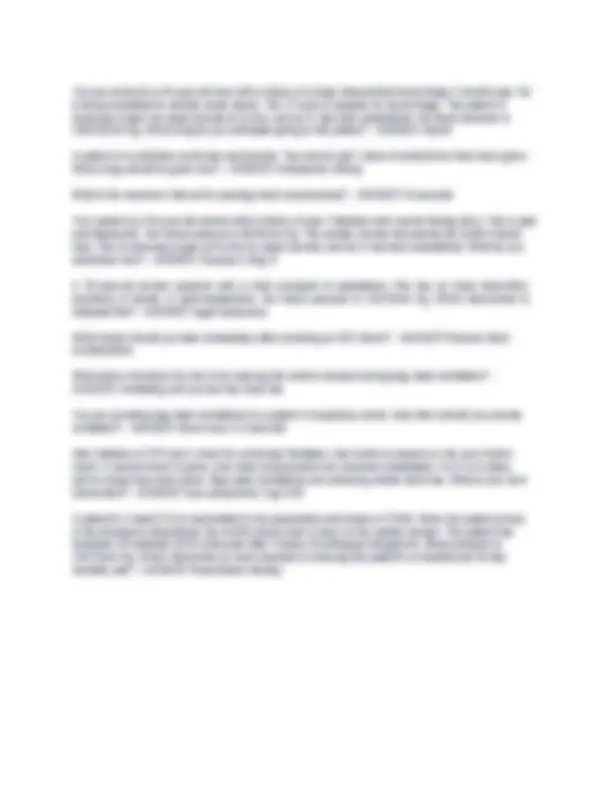
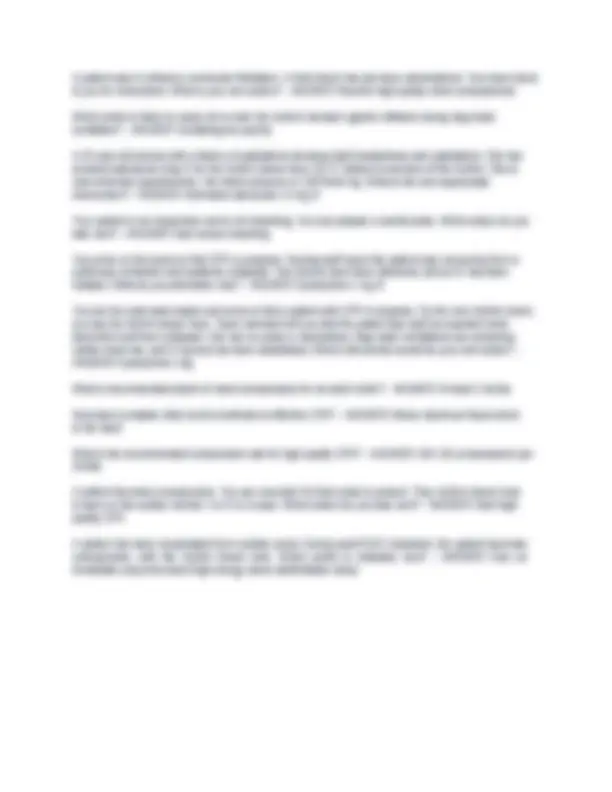
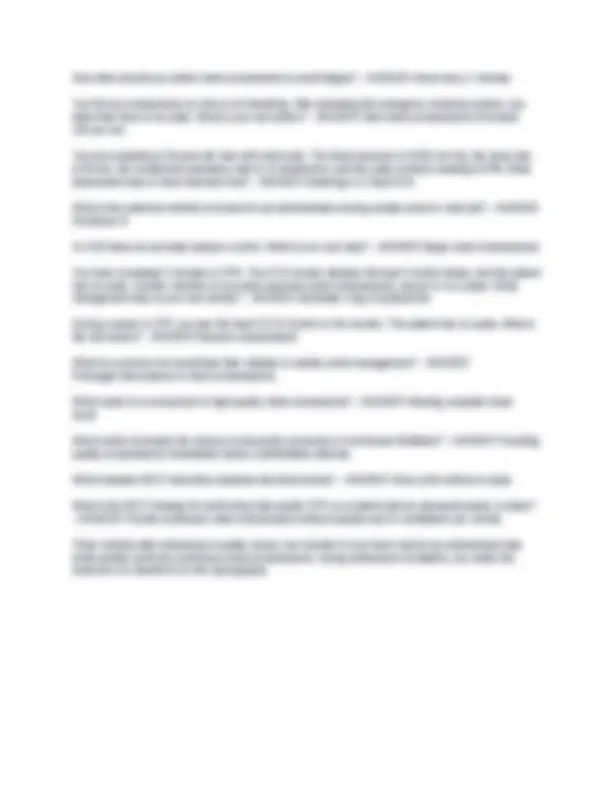
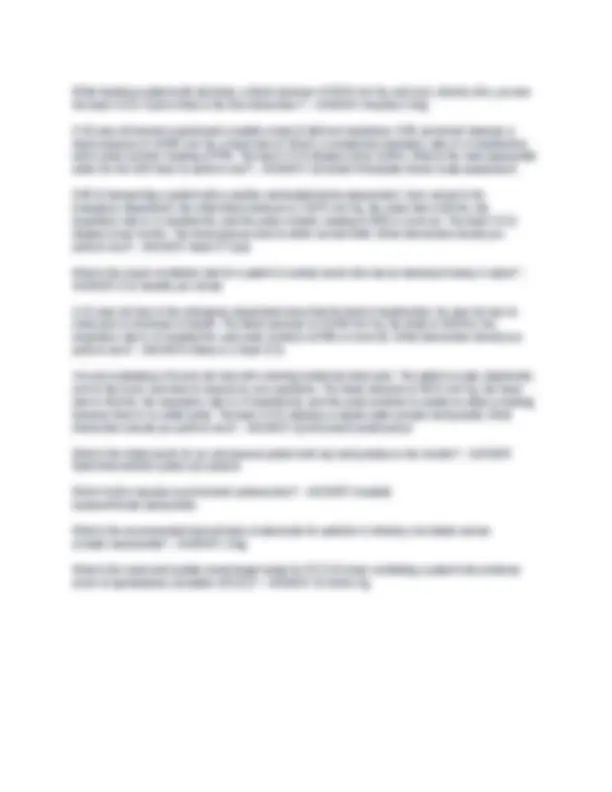

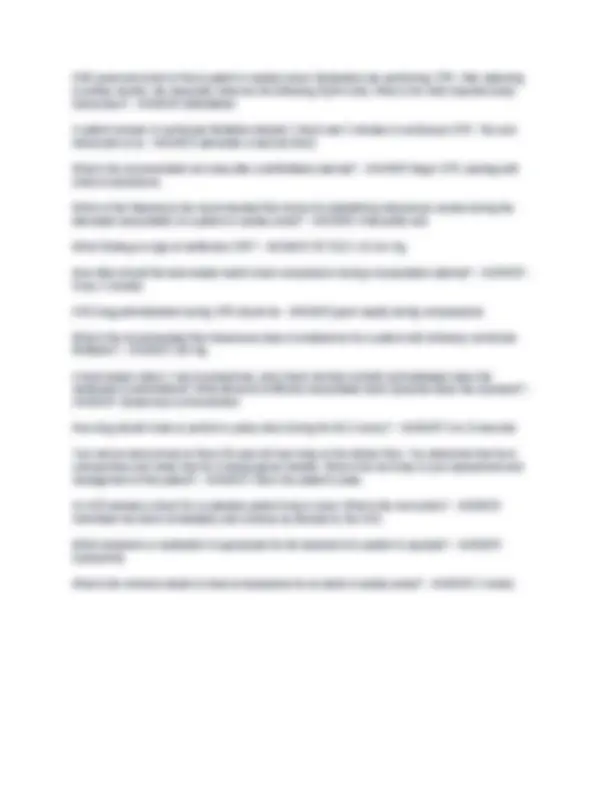
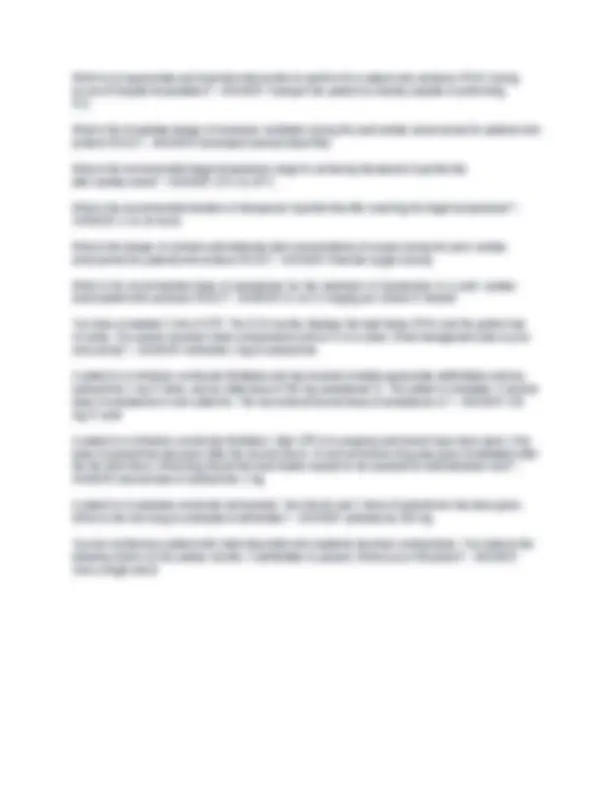
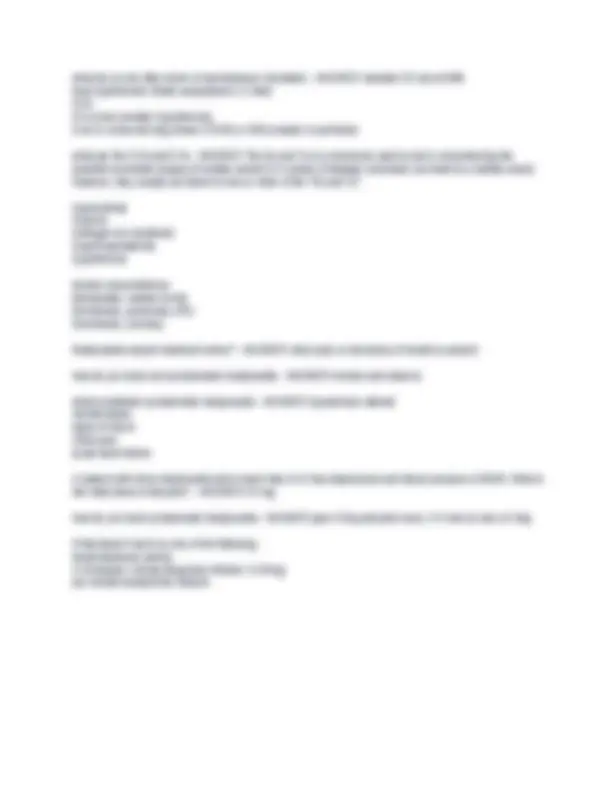
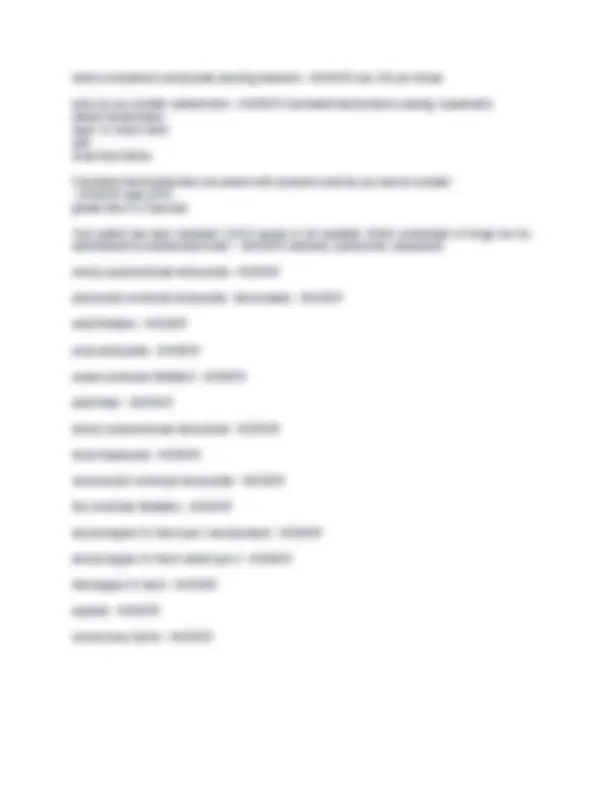
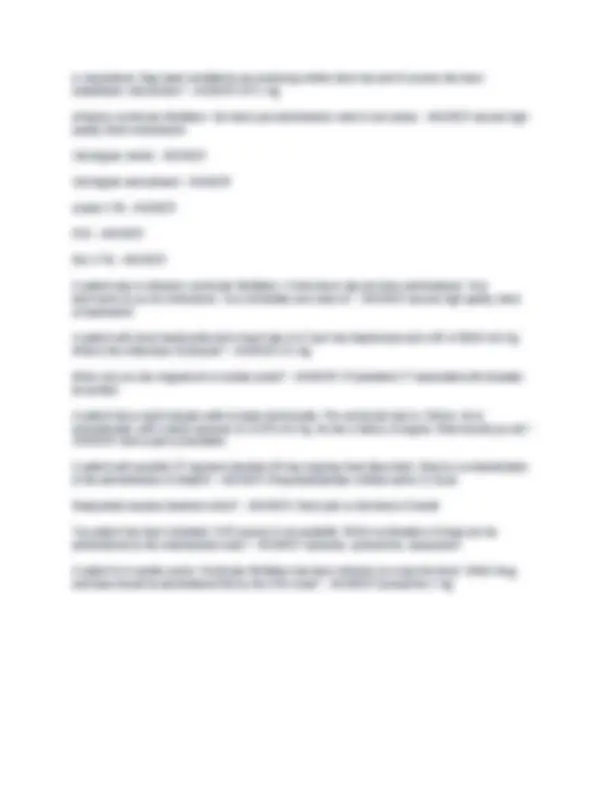
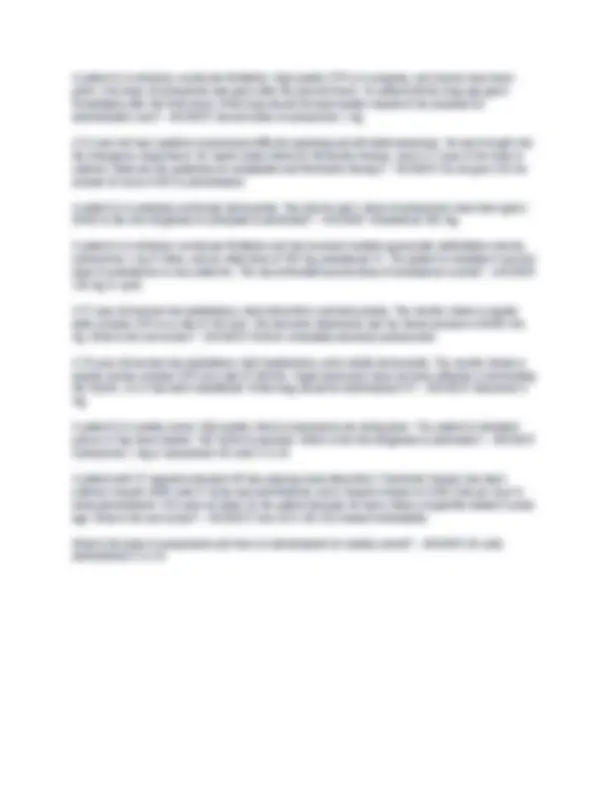
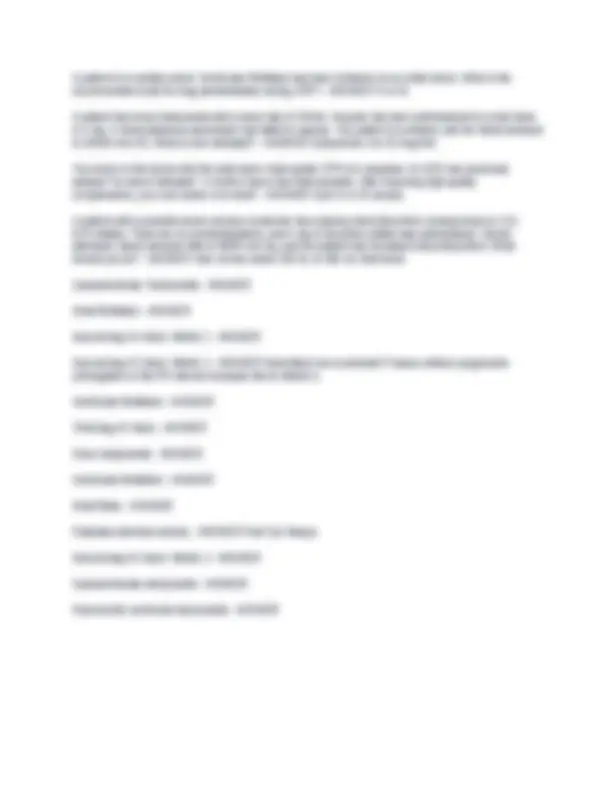
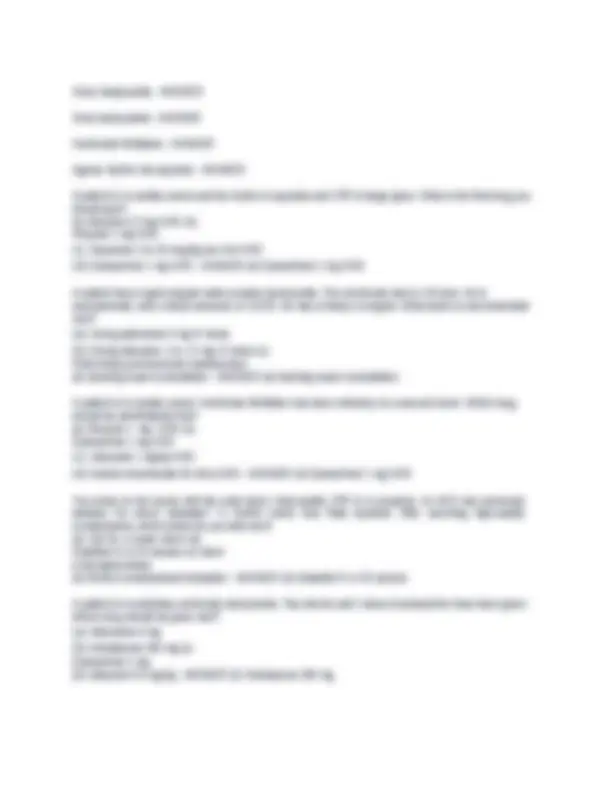
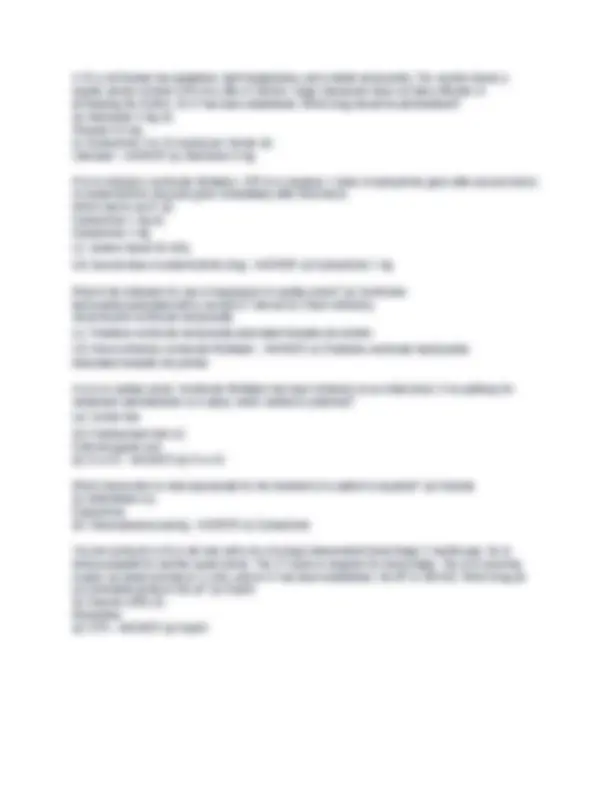
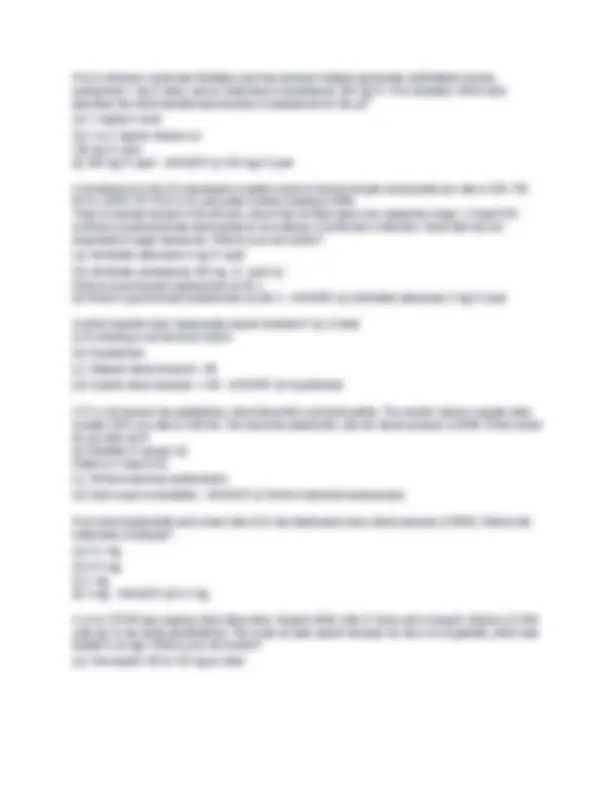
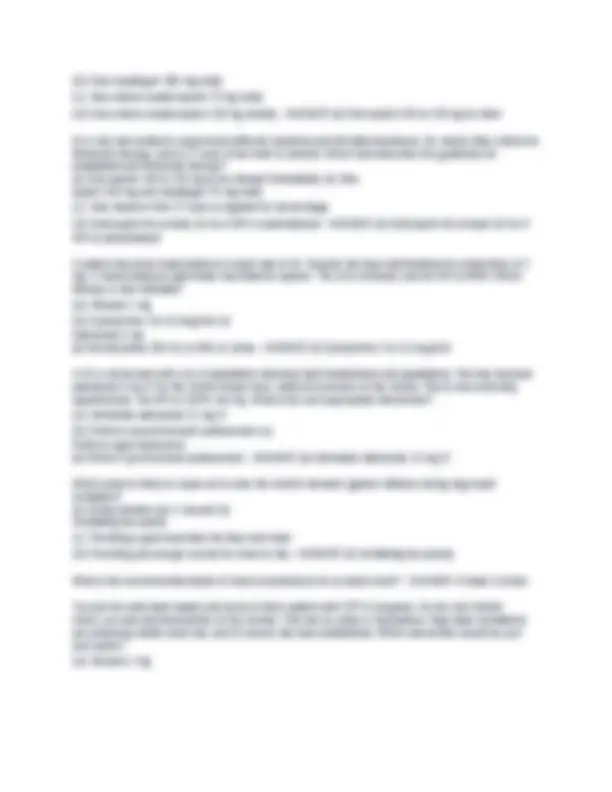
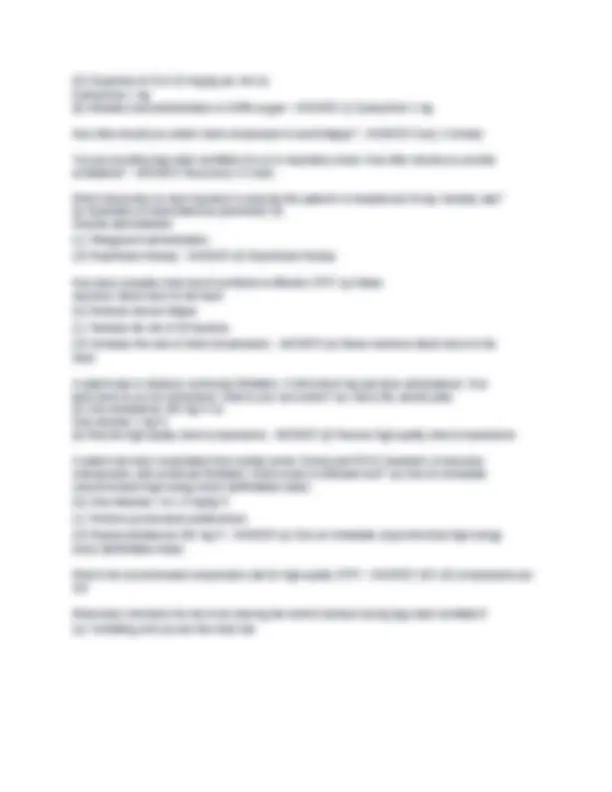
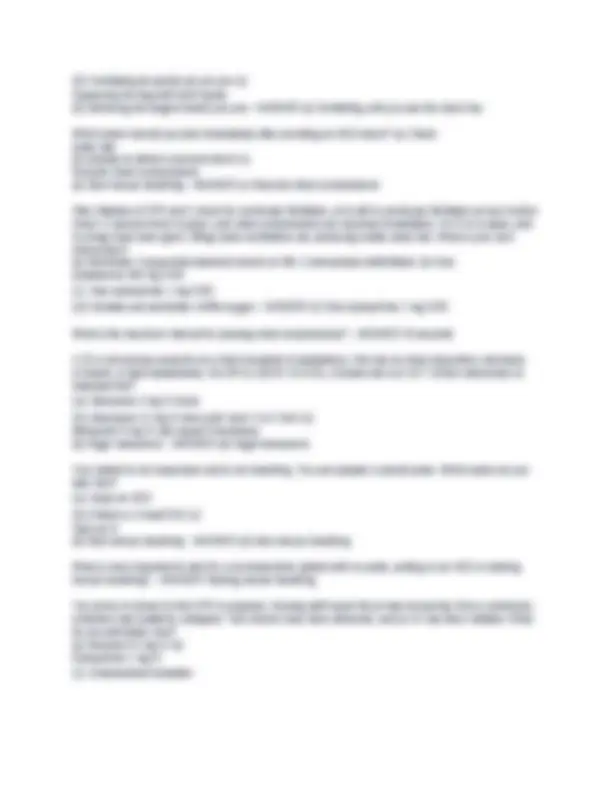
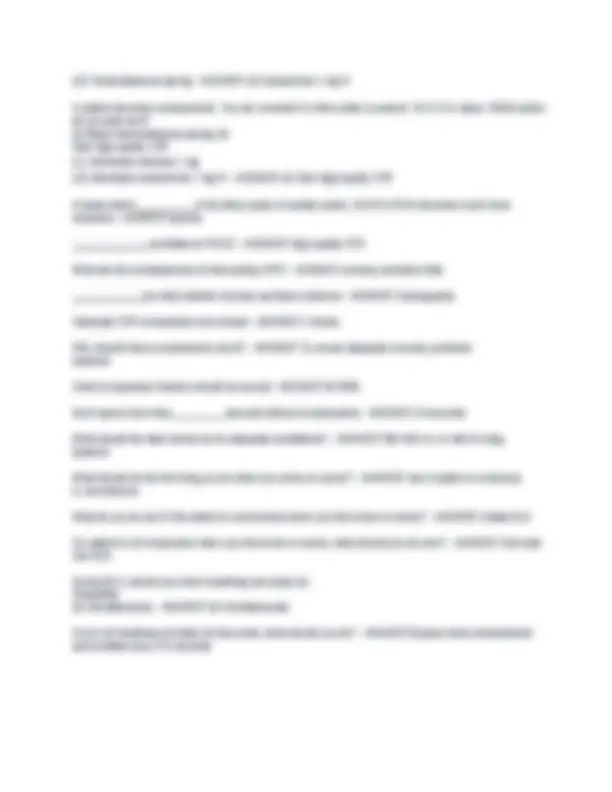
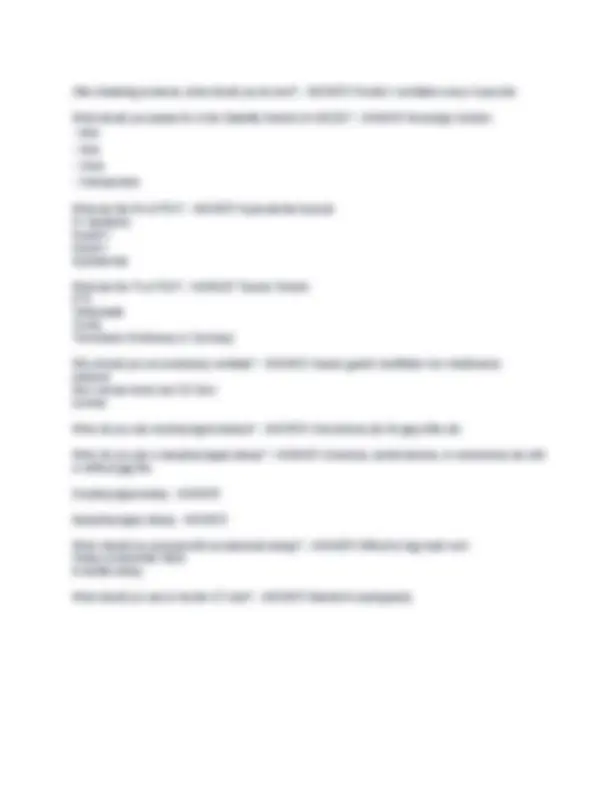
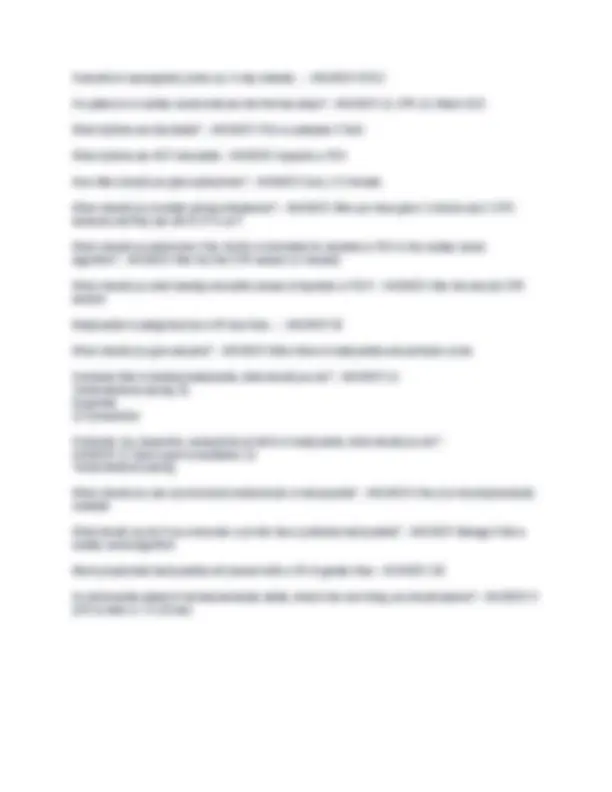
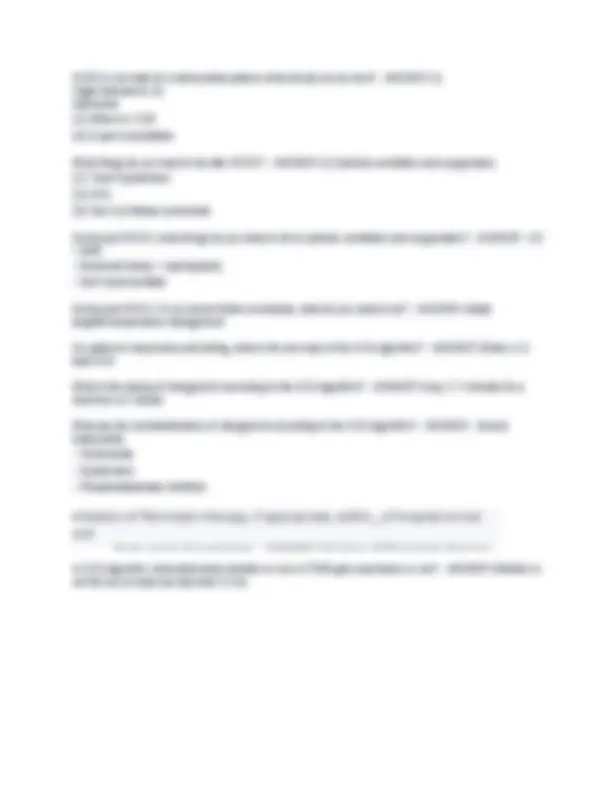


Study with the several resources on Docsity

Earn points by helping other students or get them with a premium plan


Prepare for your exams
Study with the several resources on Docsity

Earn points to download
Earn points by helping other students or get them with a premium plan
Community
Ask the community for help and clear up your study doubts
Discover the best universities in your country according to Docsity users
Free resources
Download our free guides on studying techniques, anxiety management strategies, and thesis advice from Docsity tutors
In which situation does bradycardia require treatment? - ANSWER Hypotension Which intervention is most appropriate for the treatment of a patient in asystole? - ANSWER Epinephrine You arrive on the scene with the code team. High-quality CPR is in progress. An AED has previously advised "no shock indicated." A rhythm check now finds asystole. After resuming high-quality compressions, which action do you take next? - ANSWER Establish IV or IO access A monitored patient in the ICU developed a sudden onset of narrow-complex tachycardia at a rate of 220/min. The patient's blood pressure is 128/58 mm Hg, the PETCO2 is 38mm Hg, and the pulse oximetry reading is 98%. There is vascular access in the left arm, and the patient has not been given any vasoactive drugs. A 12-lead ECG confirm a supraventricular tachycardia with no evidence of ischemia or infarction. The heart rate has not responded to vagal maneuvers. what is your next action? - ANSWER Administer adenosine 6mg IV push
Typology: Exams
1 / 30

This page cannot be seen from the preview
Don't miss anything!























https://www.youtube.com/watch? v=qQTpqjvvduI&list=PLy60DSDPg9urf_l5ss1FLakrRQDKOkTZj This is a good starting point for Jose (big Mega code at end): https://www.youtube.com/watch? v=8OB7OreUjy0. Use the feedback after failing to get closer and closer to passing! In which situation does bradycardia require treatment? - ANSWER Hypotension Which intervention is most appropriate for the treatment of a patient in asystole? - ANSWER Epinephrine You arrive on the scene with the code team. High-quality CPR is in progress. An AED has previously advised "no shock indicated." A rhythm check now finds asystole. After resuming high-quality compressions, which action do you take next? - ANSWER Establish IV or IO access A monitored patient in the ICU developed a sudden onset of narrow-complex tachycardia at a rate of 220/min. The patient's blood pressure is 128/58 mm Hg, the PETCO2 is 38mm Hg, and the pulse oximetry reading is 98%. There is vascular access in the left arm, and the patient has not been given any vasoactive drugs. A 12-lead ECG confirm a supraventricular tachycardia with no evidence of ischemia or infarction. The heart rate has not responded to vagal maneuvers. what is your next action? - ANSWER Administer adenosine 6mg IV push A patient has sinus bradycardia with a heart rate of 36/min. Atropine has been administered to a toal does of 3 mg. A transcutaneous pacemaker has failed to capture. The patient is confused, and her blood pressure is 88/56 mm Hg. Which therapy is now indicated? - ANSWER Epinephrine 2 to 10 mcg/min A patient is in cardiac arrest. Ventricular fibrillation has been refractory to a second shock. Which drug should be administered first? - ANSWER Epinephrine 1 mg IV/IO A 62-year-old man suddenly experienced difficulty speaking and left-sided weakness. He meets initial criteria for fibrinolytic therapy, and a CT scan of the brain si ordered. Which best describes the guidelines for antiplatelet and fibrinolytic therapy? - ANSWER Hold aspirin for at least 24 hours if rtPA is administered
A patient is in refractory ventricular fibrillation and has received multiple appropriate defribillation shocks, epinephrine 1 mg IV twice, and an initial dose of amiodarone 300mg IV. The patient is intubated. Which best describe the recommended second does of amiodarone for this patient? - ANSWER 150 mg IV push A patient with sinus bradycardia and a heart rate of 42/min has diaphoresis and a blood pressure of 80/60mm Hg. What is the initial does of atropine? - ANSWER 0.5mg A 35-year-old woman has palpitations, light-headedness, and a stable tachycardia. The monitor shows a regular narrow-complex QRS at a rate of 180/min. Vagal maneuvers have not been effective in terminating the rhythm. An IV has been established. Which drug should be administered? - ANSWER Adenosine 6mg A patient is in cardiac arrest. Ventricular fibrillation has been refractory to an initial shock. If no pathway for medication administration is in place, which method is preferred? - ANSWER IV or IO What is the indication for the use of magnesium in cardiac arrest? - ANSWER Pulseless ventricular tachycardia-associated torsades de pointes A patient has a rapid irregular wide-complex tachycardia. The ventricular rate is 138/min. He is asymptomatic, with a blood pressure of 110/70 mm Hg. He has a history of angina. What action is recommended next? - ANSWER Seeking expert consultation A patient is in cardiac arrest. High-quality chest compressions are being given. The patient is intubated, and an IV has been started. The rhythm is asystole. What is the first drug/dose to administer? - ANSWER Epinephrine 1mg IV/IO A patient is in refractory ventricular fibrillation. High-quality CPR is in progress. One does of epinephrine was given after the second shock. An antiarrhythmic drug was given immediately after the third shock. You are the team leader. Which medication do you order next. - ANSWER Epinephrine 1 mg A patient with possible STEMI has ongoing chest discomfort. What is a contraindication to nitrate administration? - ANSWER Use of a phosphodiestrase inhibitor within the previous 24 hours A 57-year-old woman has palpitation, chest discomfort, and tachycardia. The monitor shows a regular wide-QRS at a rate of 180/min. She becomes diaphoretic, and her blood pressure is 80/60 mm HG/ Which action do you take next? - ANSWER Perform electrical cordioversion A patient with STEMI has ongoing chest discomfort. Heparin 4000 units IV bolus and a heparin infusion of 1000 units per hour are being administered. The patient did not take aspirin because he has a history of gastritis, with was treated 5 years ago. What is your next action? - ANSWER Give aspirin 160-325 mg to chew
A patient was in refractory ventricular fibrillation. A thrid shock has just been administered. Your team looks to you for instructions. What is your next action? - ANSWER Resume high quality chest compressions Which action is likely to cause air to enter the victim's stomach (gastric inflation) during bag-mask ventilation? - ANSWER Ventilating too quickly A 45-year-old woman with a history of palpitations develops light-headedness and palpitations. She has received adensoine 6mg IV for the rhythm shown here (SVT), without conversion of the rhythm. She is now extremely apprehensive. Her blood pressure si 128/70mm Hg. What is the next appropriate intervention? - ANSWER Administer adenosine 12 mg IV Your patient is not responsive and is not breathing, You can palpate a carotid pulse. Which action do you take next? - ANSWER Start rescue breathing You arrive on the scene to find CPR in progress. Nursing staff report the patient was recovering from a pulmonary embolism and suddenly collapsed. Two shocks have been delivered, and an IV has been initiated. What do you administer now? - ANSWER Epinephrine 1 mg IV You are the code team leader and arrive to find a patient with CPR in progress. On the next rhythm check, you see the rhythm shown here. Team members tell you that the patient was well but reported chest discomfort and then collapsed. She has no pulse or respirations. Bag-mask ventilations are producing visible chest rise, and IV access has been established, Which intervention would be your next action? - ANSWER Epinephrine 1mg What is recommended depth of chest compressions for an adult victim? - ANSWER At least 2 inches How does complete chest recoil contribute to effective CPR? - ANSWER Allows maximum blood return to the heart What is the recommended compression rate for high-quality CPR? - ANSWER 100-120 compressions per minute A patient becomes unresponsive. You are uncertain if a faint pulse is present. They rhythm shown here is seen on the cardiac monitor. An IV is in pace. Which action do you take next? - ANSWER Start high- quality CPR A patient has been resuscitated from cardiac arrest. During post-ROSC treatment, the patient becomes unresponsive, with the rhythm shown here. Which action is indicated next? - ANSWER Give an immediate unsynchronized high-energy shock (defibrillation dose)
How often should you switch chest compressors to avoid fatigue? - ANSWER About every 2 minutes You find an unresponsive pt. who is not breathing. After activating the emergency response system, you determine there is no pulse. What is your next action? - ANSWER Start chest compressions of at least 100 per min. You are evaluating a 58-year-old man with chest pain. The blood pressure is 92/50 mm Hg, the heart rate is 92/min, the nonlabored respiratory rate is 14 breaths/min, and the pulse oximetry reading is 97%. What assessment step is most important now? - ANSWER Obtaining a 12 lead ECG. What is the preferred method of access for epi administration during cardiac arrest in most pts? - ANSWER Peripheral IV An AED does not promptly analyze a rythm. What is your next step? - ANSWER Begin chest compressions. You have completed 2 minutes of CPR. The ECG monitor displays the lead II rhythm below, and the patient has no pulse. Another member of your team resumes chest compressions, and an IV is in place. What management step is your next priority? - ANSWER Administer 1mg of epinephrine During a pause in CPR, you see this lead II ECG rhythm on the monitor. The patient has no pulse. What is the next action? - ANSWER Resume compressions What is a common but sometimes fatal mistake in cardiac arrest management? - ANSWER Prolonged interruptions in chest compressions. Which action is a componant of high-quality chest comressions? - ANSWER Allowing complete chest recoil Which action increases the chance of successful conversion of ventricular fibrillation? - ANSWER Providing quality compressions immediately before a defibrillation attempt. Which situation BEST describes pulseless electrical activity? - ANSWER Sinus rythm without a pulse What is the BEST strategy for performing high-quality CPR on a patient with an advanced airway in place?
A patient presents to the emergency department with new onset of dizziness and fatigue. On examination, the patient's heart rate is 35/min, the blood pressure is 70/50 mm Hg, the respiratory rate is 22 breaths/min, and the oxygen saturation is 95%. What is the appropriate first medication? - ANSWER Atropine 0.5mg A patient with dizziness and shortness of breath with a sinus bradycardia of 40/min. The initial atropine dose was ineffective, and your monitor/defibrillator is not equipped with a transcutaneous pacemaker. What is the appropriate dose of dopamine for this patient? - ANSWER 2 to 10 mcg/kg per minute A patient has sudden onset of dizziness. The patient's heart rate is 180/min, blood pressure is 110/ mm Hg, respiratory rate is 18 breaths/min, and pulse oximetry reading is 98% on room air. The lead II ECG is shown below: - ANSWER Vagal manuever. A monitored patient in the ICU developed a sudden onset of narrow-complex tachycardia at a rate of 220/min. The patient's blood pressure is 128/58 mm Hg, the PETCO2 is 38 mm Hg, and the pulse oximetry reading is 98%. There is vascular access at the left internal jugular vein, and the patient has not been given any vasoactive drugs. A 12-lead ECG confirms a supraventricular tachycardia with no evidence of ischemia or infarction. The heart rate has not responded to vagal maneuvers. What is the next recommended intervention? - ANSWER Adenosine 6mg IV push You are receiving a radio report from an EMS team en route with a patient who may be having an acute stroke. The hospital CT scanner is not working at this time. What should you do in this situation? - ANSWER Divert the patient to a hospital 15 minutes away with CT capabilities. Choose an appropriate indication to stop or withhold resuscitative efforts. - ANSWER Evidence of rigor mortis. A 49-year-old woman arrives in the emergency department with persistent epigastric pain. She had been taking oral antacids for the past 6 hours because she thought she had heartburn. The initial blood pressure is 118/72 mm Hg, the heart rate is 92/min and regular, the nonlabored respiratory rate is 14 breaths/min, and the pulse oximetry reading is 96%. Which is the most appropriate intervention to perform next? - ANSWER Obtain a 12 lead ECG. A patient in respiratory failure becomes apneic but continues to have a strong pulse. The heart rate is dropping rapidly and now shows a sinus bradycardia at a rate of 30/min. What intervention has the highest priority? - ANSWER Simple airway manuevers and assisted ventilations. What is the appropriate procedure for endotracheal tube suctioning after the appropriate catheter is selected? - ANSWER Suction during withdrawal but for no longer than 10 seconds.
While treating a patient with dizziness, a blood pressure of 68/30 mm Hg, and cool, clammy skin, you see this lead II ECG rhythm:What is the first intervention? - ANSWER Atropine 0.5mg A 68-year-old woman experienced a sudden onset of right arm weakness. EMS personnel measure a blood pressure of 140/90 mm Hg, a heart rate of 78/min, a nonlabored respiratory rate of 14 breaths/min, and a pulse oximetry reading of 97%. The lead II ECG displays sinus rhythm. What is the most appropriate action for the EMS team to perform next? - ANSWER Cincinnati Prehospital Stroke Scale assessment EMS is transporting a patient with a positive prehospital stroke assessment. Upon arrival in the emergency department, the initial blood pressure is 138/78 mm Hg, the pulse rate is 80/min, the respiratory rate is 12 breaths/min, and the pulse oximetry reading is 95% on room air. The lead II ECG displays sinus rhythm. The blood glucose level is within normal limits. What intervention should you perform next? - ANSWER Head CT scan What is the proper ventilation rate for a patient in cardiac arrest who has an advanced airway in place? - ANSWER 8-10 breaths per minute A 62-year-old man in the emergency department says that his heart is beating fast. He says he has no chest pain or shortness of breath. The blood pressure is 142/98 mm Hg, the pulse is 200/min, the respiratory rate is 14 breaths/min, and pulse oximetry is 95% on room air. What intervention should you perform next? - ANSWER Obtain a 12 lead ECG. You are evaluating a 48-year-old man with crushing substernal chest pain. The patient is pale, diaphoretic, cool to the touch, and slow to respond to your questions. The blood pressure is 58/32 mm Hg, the heart rate is 190/min, the respiratory rate is 18 breaths/min, and the pulse oximeter is unable to obtain a reading because there is no radial pulse. The lead II ECG displays a regular wide-complex tachycardia. What intervention should you perform next? - ANSWER Synchronized cardioversion What is the initial priority for an unconscious patient with any tachycardia on the monitor? - ANSWER Determine whether pulses are present. Which rhythm requires synchronized cardioversion? - ANSWER Unstable supraventricular tachycardia What is the recommended second dose of adenosine for patients in refractory but stable narrow- complex tachycardia? - ANSWER 12mg What is the usual post-cardiac arrest target range for PETCO2 when ventilating a patient who achieves return of spontaneous circulation (ROSC)? - ANSWER 35-40mm Hg
EMS personnel arrive to find a patient in cardiac arrest. Bystanders are performing CPR. After attaching a cardiac monitor, the responder observes the following rhythm strip. What is the most important early intervention? - ANSWER defibrillation A patient remains in ventricular fibrillation despite 1 shock and 2 minutes of continuous CPR. The next intervention is to - ANSWER administer a second shock. What is the recommended next step after a defibrillation attempt? - ANSWER Begin CPR, starting with chest compressions. Which of the following is the recommended first choice for establishing intravenous access during the attempted resuscitation of a patient in cardiac arrest? - ANSWER Antecubital vein Which finding is a sign of ineffective CPR? - ANSWER PETCO2 <10 mm Hg How often should the team leader switch chest compressors during a resuscitation attempt? - ANSWER. Every 2 minutes IV/IO drug administration during CPR should be - ANSWER given rapidly during compressions What is the recommended first intravenous dose of amiodarone for a patient with refractory ventricular fibrillation? - ANSWER 300 mg A team leader orders 1 mg of epinephrine, and a team member verbally acknowledges when the medication is administered. What element of effective resuscitation team dynamics does this represent? - ANSWER Closed-loop communication How long should it take to perform a pulse check during the BLS Survey? - ANSWER 5 to 10 seconds Your rescue team arrives to find a 59-year-old man lying on the kitchen floor. You determine that he is unresponsive and notice that he is taking agonal breaths. What is the next step in your assessment and management of this patient? - ANSWER Check the patient's pulse. An AED advises a shock for a pulseless patient lying in snow. What is the next action? - ANSWER Administer the shock immediately and continue as directed by the AED. Which treatment or medication is appropriate for the treatment of a patient in asystole? - ANSWER Epinephrine What is the minimum depth of chest compressions for an adult in cardiac arrest? - ANSWER 2 inches
A patient with pulseless ventricular tachycardia is defibrillated. What is the next action? - ANSWER Start chest compressions at a rate of at least 100/min. You have completed your first 2-minute period of CPR. You see an organized, nonshockable rhythm on the ECG monitor. What is the next action? - ANSWER Have a team member attempt to palpate a carotid pulse. Emergency medical responders are unable to obtain a peripheral IV for a patient in cardiac arrest. What is the next most preferred route for drug administration? - ANSWER Intraosseous (IO) What is the appropriate rate of chest compressions for an adult in cardiac arrest? - ANSWER At least 100/min You are receiving a radio report from an EMS team en route with a patient who may be having an acute stroke. The hospital CT scanner is not working at this time. What should you do in this situation? - ANSWER Divert the patient to a hospital 15 minutes away with CT capabilities. A 53-year-old man has shortness of breath, chest discomfort, and weakness. The patient's blood pressure is 102/59 mm Hg, the heart rate is 230/min, the respiratory rate is 16 breaths/min, and the pulse oximetry reading is 96%. The lead II ECG is displayed below. A patent peripheral IV is in place. What is the next action? - ANSWER Vagal maneuvers A 49-year-old man has retrosternal chest pain radiating into the left arm. The patient is diaphoretic, with associated shortness of breath. The blood pressure is 130/88 mm Hg, the heart rate is 110/min, the respiratory rate is 22 breaths/min, and the pulse oximetry value is 95%. The patient's 12-lead ECG shows ST-segment elevation in the anterior leads. First responders administered 160 mg of aspirin, and there is a patent peripheral IV. The pain is described as an 8 on a scale of 1 to 10 and is unrelieved after 3 doses of nitroglycerin. What is the next action? - ANSWER Administer 2 to 4 mg of morphine by slow IV bolus. A 56-year-old man reports that he has palpitations but not chest pain or difficulty breathing. The blood pressure is 132/68 mm Hg, the pulse is 130/min and regular, the respiratory rate is 12 breaths/min, and the pulse oximetry reading is 95%. The lead II ECG displays a wide-complex tachycardia. What is the next action after establishing an IV and obtaining a 12-lead ECG? - ANSWER Seeking expert consultation A postoperative patient in the ICU reports new chest pain. What actions have the highest priority? - ANSWER Obtain a 12-lead ECG and administer aspirin if not contraindicated. An 80-year-old woman presents to the emergency department with dizziness. She now states she is asymptomatic after walking around. Her blood pressure is 102/72 mm Hg.
Which is an appropriate and important intervention to perform for a patient who achieves ROSC during an out-of-hospital resuscitation? - ANSWER Transport the patient to a facility capable of performing PCI. What is the immediate danger of excessive ventilation during the post-cardiac arrest period for patients who achieve ROSC? - ANSWER Decreased cerebral blood flow What is the recommended target temperature range for achieving therapeutic hypothermia after cardiac arrest? - ANSWER 32°C to 34°C What is the recommended duration of therapeutic hypothermia after reaching the target temperature? - ANSWER 12 to 24 hours What is the danger of routinely administering high concentrations of oxygen during the post- cardiac arrest period for patients who achieve ROSC? - ANSWER Potential oxygen toxicity What is the recommended dose of epinephrine for the treatment of hypotension in a post- cardiac arrest patient who achieves ROSC? - ANSWER 0.1 to 0.5 mcg/kg per minute IV infusion You have completed 2 min of CPR. The ECG monitor displays the lead below (PEA) and the patient has no pulse. You partner resumes chest compressions and an IV is in place. What management step is your next priority? - ANSWER Administer 1mg of epinephrine A patient is in refractory ventricular fibrillation and has received multiple appropriate defibrillation shocks, epinephrine 1 mg IV twice, and an initial dose of 300 mg amiodarone IV. The patient is intubated. A second dose of amiodarone is now called for. The recommend second dose of amiodarone is? - ANSWER 150 mg IV push A patient is in refractory ventricular fibrillation. High CPR is in progress and shocks have been given. One dose of epinephrine was given after the second shock. An anti arrhythmic drug was given immediately after the the third shock. What drug should the team leader request to be prepared for administration next? - ANSWER second dose of epinephrine 1 mg A patient is in pulseless ventricular tachycardia. Two shocks and 1 dose of epinephrine has been given. Which is the next drug to anticipate to administer? - ANSWER amiodarone 300 mg You are monitoring a patient with chest discomfort who suddenly becomes unresponsive. You observe the following rhythm on the cardiac monitor. A defibrillator is present. What is your first action? - ANSWER Give a single shock
what do you do after return of spontaneous circulation - ANSWER maintain O2 sat at 94% treat hypotension (fluids vasopressor) 12 lead EKG if in coma consider hypothermia if not in coma and ekg shows STEMI or AMI consider re-perfusion what are the 5 h's and 5 t's - ANSWER The Hs and Ts is a mnemonic used to aid in remembering the possible reversible causes of cardiac arrest.[1] A variety of disease processes can lead to a cardiac arrest; however, they usually boil down to one or more of the "Hs and Ts". hypovolemia hypoxia hydrogen ion (acidosis) hypo/hyperkalemia hypothermia tension pneumothorax tamponade, cardiac toxins thrombosis, pulmonary (PE) thrombosis, coronary Bradycardia require treatment when? - ANSWER chest pain or shortness of breath is present how do you treat non-symptomatic bradycardia - ANSWER monitor and observe what constitutes symptomatic bradycardia - ANSWER hypotension altered mental status signs of shock chest pain acute heart failure A patient with sinus bradycardia and a heart rate of 42 has diaphoresis and blood pressure of 80/60. What is the initial dose of atropine? - ANSWER 0.5 mg how do you treat symptomatic bradycardia - ANSWER give 0.5mg atropine every 3-5 mins to max of 3mg if that doesn't work try one of the following: transcutaneous pacing 2-10mcg/kg / minute dopamine infusion 2-10mcg per minute epinephrine infusion
pulseless electrical activity - ANSWER agonal rhythm/asystole - ANSWER The five links in the adult Chain of Survival - ANSWER 1- Immediate activation of EMS 2- Early CPR 3- Rapid defibrillation (not in peds) 4- Effective advanced life support 5- Integrated post-cardiac arrest care Type of breaths (not normal) that may be present in the first minutes after sudden cardiac arrest - ANSWER Agonal gasps To place the pads on the victims bare chest, Place one pad on the upper-right chest (below the collarbone) and place the other pad - ANSWER to the side of the left nipple, with the top edge of the pad a few inches below the armpit If the heart muscle resets and initiates an organized rhythm this is called - ANSWER ROSC return of spontaneous circulation a patient is in cardiac arrest. ventricular fibrillation has been refractory to an initial shock. if no pathway for medication is in place, preferred method? - ANSWER IV or IO A patient has sinus bradycardia with a heart rate of 36/min. Atropine has been administered to a total dose of 3 mg. A transcutaneous pacemaker has failed to capture. The patient is confused, and her blood pressure is 100/60 mm HG. What is now indicated? - ANSWER EPI 2-10 mcg/min A patient with ST-segment elevation MI has ongoing chest discomfort. Fibrinolytic therapy has been ordered. Heparin 4000 units IV bolus was administered, and a heparin infusion of 1000 units per hour is being administered. ASA was not taken by the patient because he had a history of gastritis treated 5 years ago. What is the next action? - ANSWER ASA 160-325 mg chew A patient has a rapid irregular wide-complex tachycardia. The ventricular rate is 138/min. He is asymptomatic, with a blood pressure of 110/70 mm Hg. He has a history of angina. What should you do? - ANSWER seek expert consultation A 35 year old woman has palpitations, light headedness, and a stable tachycardia. The monitor shows a regular narrow-complex QRS at a rate of 180/min. Vagal maneuvers have not been effective in terminating the rhythm. An IV has been established. What drug should be administered? - ANSWER adenosine 6 mg
A 57 year old woman has palpitations, chest discomfort, and tachycardia. The monitor shows a regular wide-complex QRS at a rate of 180 bpm. She becomes diaphoretic and her blood pressure is 80/60 mm Hg. What is the next action? - ANSWER cardioversion when does bradycardia require treatment? - ANSWER hypotension You arrive on the scene with the code team. High-quality CPR is in progress. An AED has previously advised "no shock indicated". A rhythm check now finds asystole. After resuming high-quality compressions, your next action is to what? - ANSWER establish IV or IO access you are caring for a 66 year old man with a history of a large intracerebral hemorrhage 2 months ago. He is being evaluated for another acute stroke. the ct scan is negative for hemorrhage. The patient is receiving oxygen via nasal cannula at 2 L/min, and an IV has been established. His blood pressure is 180/100 mm Hg. Which drug do you anticipate giving? - ANSWER aspirin A 62 year old man suddenly experienced difficulty speaking and left-sided weakness. He was brought into the emergency department. He meets initial criteria for fibrinolytic therapy, and a CT scan of the brain is ordered. What are the guidelines for antiplatelet and fibrinolytic therapy? - ANSWER hold aspirin for at least 24 hours if rtPA is administered a 45 year old woman has a history of palpitations develops lightheadedness and palpitations. She has received adenosine 6 mg IV for SVT without conversion. BP 128/70. next step? - ANSWER adenosine 12 mg STEMI intervention is most important in reducing patients in hospital and 30 day mortality? - ANSWER reperfusion therapy a patient has been resuscitated from cardiac arrest. During post-ROSC treatment, the patient becomes unresponsive, with the rhythm VT. What tx is indicated - ANSWER unsynchronized high energy shock which action should you take immediately after providing an AED shock - ANSWER resume chest compressions which action causes air to enter victim's stomach (gastric inflation) during bag-mask ventilation - ANSWER ventilation too quickly, A patient becomes unresponsive. You are uncertain if a faint pulse is present with the rhythm below. What is your next action? - ANSWER CPR you are the code team leader and arrive to find a patient with CPR in progress. On next rhythm check NSR. Pt reported chest discomfort and then collapsed. She has no pulse
A patient is in refractory ventricular fibrillation. High quality CPR is in progress, and shocks have been given. One dose of epinephrine was given after the second shock. An antiarrhythmic drug was given immediately after the third shock. What drug should the team leader request to be prepared for administration next? - ANSWER Second dose of epinephrine 1 mg A 62 year old man suddenly experienced difficulty speaking and left-sided weakness. He was brought into the emergency department. He meets initial criteria for fibrinolytic therapy, and a CT scan of the brain is ordered. What are the guidelines for antiplatelet and fibrinolytic therapy? - ANSWER Do not give ASA for at least 24 hours if rtPA is administered A patient is in pulseless ventricular tachycardia. Two shocks and 1 dose of epinephrine have been given. Which is the next drug/dose to anticipate to administer? - ANSWER Amiodarone 300 mg A patient is in refractory ventricular fibrillation and has received multiple appropriate defibrillation shocks, epinephrine 1 mg IV twice, and an initial dose of 300 mg amiodarone IV. The patient is intubated A second dose of amiodarone is now called for. The recommended second dose of amiodarone is what? - ANSWER 150 mg IV push A 57 year old woman has palpitations, chest discomfort, and tachycardia. The monitor shows a regular wide-complex QRS at a rate of 180 bpm. She becomes diaphoretic and her blood pressure is 80/60 mm Hg. What is the next action? - ANSWER Perform immediate electrical cardioversion A 35 year old woman has palpitations, light headedness, and a stable tachycardia. The monitor shows a regular narrow-complex QRS at a rate of 180/min. Vagal maneuvers have not been effective in terminating the rhythm. An IV has been established. What drug should be administered IV? - ANSWER Adenosine 6 mg A patient is in cardiac arrest. High quality chest compressions are being given. The patient is intubated and an IV has been started. The rhythm is asystole. Which is the first drug/dose to administer? - ANSWER Epinephrine 1 mg or vasopressin 40 units IV or IO A patient with ST-segment elevation MI has ongoing chest discomfort. Fibrinolytic therapy has been ordered. Heparin 4000 units IV bolus was administered, and a heparin infusion of 1000 units per hour is being administered. ASA was not taken by the patient because he had a history of gastritis treated 5 years ago. What is the next action? - ANSWER Give ASA 160-325 chewed immediately What is the dose of vasopressin and how is it administered (in cardiac arrest)? - ANSWER 40 units administered IV or IO
A patient is in cardiac arrest. Ventricular fibrillation has been refractory to an initial shock. What is the recommended route for drug administration during CPR? - ANSWER IV or IO A patient has sinus bradycardia with a heart rate of 36/min. Atropine has been administered to a total dose of 3 mg. A transcutaneous pacemaker has failed to capture. The patient is confused, and her blood pressure is 100/60 mm HG. What is now indicated? - ANSWER Epinephrine 2 to 10 mcg/min You arrive on the scene with the code team. High-quality CPR is in progress. An AED has previously advised "no shock indicated". A rhythm check now finds asystole. After resuming high-quality compressions, your next action is to what? - ANSWER Gain IV or IO access A patient with a possible acute coronary syndrome has ongoing chest discomfort unresponsive to 3 SL NTG tablets. There are no contraindications, and 4 mg of morphine sulfate was administered. Shortly afterward, blood pressure falls to 88/60 mm Hg, and the patient has increased chest discomfort. What should you do? - ANSWER Give normal saline 250 mL to 500 mL fluid bolus Supraventricular Tachycardia - ANSWER Atrial fibrillation - ANSWER Second deg AV block: Mobitz 1 - ANSWER Second deg AV block: Mobitz 2 - ANSWER Intermittent non-conducted P waves without progressive prolongation of the PR interval (compare this to Mobitz I). Ventricular fibrillation - ANSWER Third deg AV block - ANSWER Sinus bradycardia - ANSWER Ventricular fibrillation - ANSWER Atrial flutter - ANSWER Pulseless electrical activity - ANSWER Push Epi Always Second deg AV block: Mobitz 2 - ANSWER Supraventricular tachycardia - ANSWER Polymorphic ventricular tachycardia - ANSWER